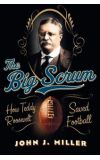
13 Apr 2011 03:39:49
Sports history meets social history in "The Big Scrum" as John J. Miller examines the early years of an all-too-deadly pastime and why only presidential intervention may have saved football from the fate of cockfighting. Miller's easygoing narrative and keen eye for colorful detail should cheer sports fans and history buffs alike.
Football addicts are fortunate that T.R. was the man in the White House when, in 1905, no fewer than 18 players died from injuries suffered on the field. Roosevelt was sensitive to his fellow Progressives who felt scorn for the brutal game and demanded it be abolished. But he, too, was a product of the times, a period in which physical fitness began to be promoted on the same level as mental agility.
Miller juxtaposes the decades-long evolution of football from a rugby-meets-soccer knockoff to an all-American sport with Roosevelt's own transformation from sickly rich kid to hardy, adventurous youth. He was still rich, of course, and all the better able to enjoy the things — boxing lessons and big-game hunts were but two — that came with wealth.
In presenting a joint history of football and the 26th president, Miller focuses far more on why Roosevelt got involved than what he actually did as president to make a difference. Fewer side trips into the minutiae of both subjects might have put more energy into this dual narrative.
But then readers could have missed out on the fact that painter Frederic Remington once soiled his college football uniform with slaughterhouse blood to make it appear "more businesslike." And that college student Woodrow Wilson, later a Roosevelt nemesis, extolled the virtues of football for the Princeton newspaper and even served as an officer for the college team. And that a dead player's mother almost single-handedly stopped an effort to ban football in Georgia.
Roosevelt enjoyed solving problems, even those that didn't concern his office. He used his bully pulpit to cajole modern football's founders into revising the rules — the forward pass was one innovation — to make the game less lethal. In doing so, T.R. scored a touchdown for American sports.

